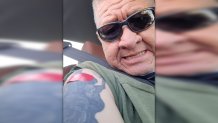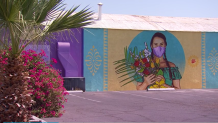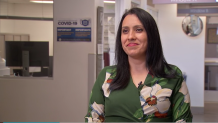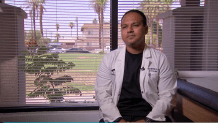COVID-19 has now claimed more than 604,000 American lives. NBC 7 Investigates has been tracking death rates per county, and found a staggering contrast across California. Some counties reported nearly four times as many COVID-19 deaths as others.
According to the COVID-19 deaths reported to the Centers for Disease Control and Prevention (CDC), San Diego County has seen 132 deaths per 100,000 people. That’s better than the average for California counties -- 164. Riverside County has reported 209 deaths per 100,000 people, and Imperial County has reported 323 deaths - the highest rate in the state.
Public health officials say there are several factors at play in the death rate disparities, such as the types of jobs people work in each county and public interventions, like stay-at-home orders and mask mandates, which San Diego County put in place in May 1, 2020.
“That’s really effective intervention because if you do get sick, if you’re wearing a mask, you get less virus and you get less sick,” said Rebecca Fielding-Miller, MSPH Ph.D., an assistant professor at the Herbert Wertheim School of Public Health, University of California, San Diego.
Bay Area counties reported significantly lower death rates. For example, San Francisco reported about 57 deaths per 100,000 people. “People are a lot wealthier in San Francisco,” said Fielding-Miller. She says people who call the Bay Area home are more likely to work jobs in tech, meaning they could work from home.
That’s not the case in Riverside and Imperial Counties. Both regions are home to frontline essential workers and farm workers who didn’t have that luxury.
NBC 7 Investigates asked the California Department of Public Health about the death rate disparities. They told us, “Several factors, some of which are outlined in the California Department of Public Health’s equity dashboard, affect COVID-19 outcomes among California communities. For example, death rates for Latino people are 21% higher than statewide. Other factors that affect health outcomes include vaccination rates, income and housing conditions. The California Healthy Places Index (HPI) is a helpful tool for comparing community conditions: in general, communities with lower HPI percentile have less favorable conditions and worse health outcomes.”
Mixed Messages from Riverside County Officials
The Riverside County Department of Public Health tells NBC 7 Investigates the COVID-19 death toll is grim, but it makes sense given the number of agriculture jobs, lack of access to healthcare, and even lack of access to the internet - all of which makes getting public health messages through to everyone a challenge.
It’s especially true when you’re competing with other voices. The Riverside County Sheriff made national headlines when he posted a video online after the December statewide shutdown order. “Those closures and stay-at-home orders are flat out ridiculous,” Sheriff Chad Bianco said in the video.
Some of those who lost loved ones to COVID-19 believe those mixed messages played a role in the death rate.
“When you have leaders that just don’t show concern, that’s wrong,” said Cindy Mendoza-Collins. “I think it played a role in keeping people from taking it seriously and not wearing a mask.”

Mendoza-Collins’ brother, Morris Mendoza, was a lifelong activist in Riverside. A street is named after him in the Casa Blanca neighborhood where he fought for affordable housing. Morris Mendoza,72, died in January. Mendoza’s friends and family say his death motivated many to get the vaccine. A Latino community leader, still leading, even in death. “He’ll leave a big void. He still does and I think he always will,” his sister said.
Imperial County Struggles to Contain the Virus
As of June 16, more than 2,000 people had died from COVID-19 in Imperial County. That’s more than any other county, per capita, in the state. Jimmy Rios is among those deaths. He celebrated his 50th birthday not long before contracting the virus.
“He had recently received a kidney transplant so we all expected that he would be with us for a long time,” his father, Jesse Rios, said.

Just five months after Jimmy received the transplant, both he and his father were hospitalized at El Centro Regional Medical Center with COVID-19. A few weeks later, the elder Rios learned his son would not be going home.
“It was like, I wanted to become God and say, ‘Get up son,'” Rios said.

Rios and the other lives lost to the pandemic in Imperial County are memorialized in a mural recently painted in El Centro. A closer look reveals a few names, including Efren Coronel, an El Centro police officer who contracted the virus while on patrol.
“He loved his community, as a police officer he always wanted to help others,” his widow, Sandra Coronel, said. “He always enjoyed life to the fullest."

County leaders tell NBC 7 Investigates they did everything they could to control the spread of the virus.
County Supervisor Luis Plancarte was chair of the board at the height of the pandemic. “We began to all of a sudden see that our care facilities, our services, our ambulances were taxed to the limit,” Plancarte said.
“We weren’t getting a few cases a day, we were getting hundreds of cases a day,” said Janette Angulo, the county’s public health director.
Angulo remembers the week in May 2020 that the pandemic completely overwhelmed the county’s limited resources.
“Systems that we had in place, data systems that we did not have in place, just to give you an example - we were hand-delivering isolation orders,” Angulo said\.

Angulo recalls reaching out to the state for help, but says they were hit with another setback pretty much on day one.
“We initially received assistance from the state for contact tracing and investigation. It was a bit challenging initially for us because we needed bilingual contact tracers and investigators because of the makeup of the community.”
As local hospitals became saturated, the state took over patient transfers to other counties, as far north as San Francisco. Dr. Pedro Colio, who was on the frontlines at the hospital in El Centro, took issue with this strategy.
“So if you came in with a severe condition such as a heart attack and you needed a cardiac cath lab, but you also had COVID, we had to call the state line instead of transferring you to the nearest cardiac center,” Dr. Colio said. “So our patients were sitting in the ER for up to 24 hours while their hearts were deteriorating with heart failure.”
NBC 7 Investigates contacted the California Emergency Medical Services Authority for a response but they did not respond by the time this article was published.
Imperial County borders the city of Mexicali, which has a population of well over a million people, which is about six times more than the population of Imperial County. Health experts say what happened in Mexicali during the pandemic impacted the county.
“We all have family on the other side and they come to see us on a weekly or monthly basis and we do the same,” said County Supervisor Plancarte.
Colio also correlates the county’s high poverty rates to the high mortality rate. More people living in the same home accelerates the spread of the virus.
“Poverty also leads to chronic conditions like diabetes, heart failure, COPD, and these patients, unfortunately, are the ones that will get very ill because their immune [system] is low,” Colio said.

And when the vaccines finally started rolling out in December, Colio wonders how many lives could’ve been saved had the distribution been handled differently by the state.
“It should've been distributed based on mortality rate rather than population size because even though our population is smaller here, our mortality rate was a lot higher, so I think we should've received more vaccines than we actually did.”
In a statement, the California Department of Public Health (CDPH) said, “CDPH and the Vaccination Task Force developed a strategy called The Blueprint For Safer Economy which created a vaccine equity metric. The objective was to increase vaccination in the state's hardest-hit communities. The initial goal of the metric was to deliver a minimum of 2 million doses to the hardest-hit quarter of the state as measured by the Healthy Place Index. We did get to that goal.”

